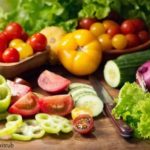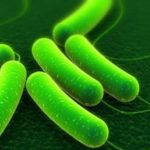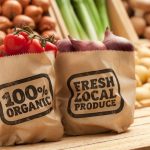The FDA has released a report on avocado and hot pepper sampling, as part of their "new, proactive sampling program," that was adopted in 2014. The program attempts to help public health investigators identify patterns in certain foods that may help reduce microbial contamination. They found Listeria monocytogenes on 17.73% of the avocado skin samples. They found the overall prevalence of Salmonella on the samples to be about 0.74%. That means that, if you don't rinse the avocado before you cut into it, you will spread any pathogens on the skin into the flesh. And because this fruit is usually eaten uncooked, there is no kill step to destroy that bacteria before you eat it. The FDA began collecting avocados in May 2015. They collected 1,615 samples to test for Salmonella and … [Read more...]
What Is the Best Way to Wash Fruits and Vegetables?
Consumers are understandably nervous about the new romaine lettuce growing season in the Yuma, Arizona region after the large E. coli O157:H7 outbreak that was linked to that product earlier this year. In that outbreak, 210 people were sickened, and 96 people were hospitalized. Five people died. So how should you, and can you, wash fruits and vegetables to help get rid of pathogens? The FDA and CDC never did solve this outbreak, and never identified a single farm or product that caused the illnesses. They did, however, find that canal water that may have been used for irrigation or to dilute crop chemicals was contaminated with the outbreak strain. One of the issues with that outbreak was that most of the illnesses were caused by chopped romaine. Lettuce from many different farms … [Read more...]
CDC Offers Tips on Fruit and Vegetable Safety Amid Cyclospora and Salmonella Outbreaks
There are two outbreaks right now in the U.S. that are linked to fresh produce. A cyclospora outbreak linked to Del Monte Vegetable Trays has sickened 212 people in Minnesota, Wisconsin, Iowa, and Michigan. And a Salmonella Adelaide outbreak linked to recalled fresh precut melons has sickened. So the CDC is offering advice on fruit and vegetable safety. Fruits and vegetables are important to a good diet. They help protect y0u from illnesses such as heart disease, stroke, and some cancers. But these types of foods are more likely than others to be contaminated with pathogenic bacteria. And many of these products are not heated before they are consumed, which means any contaminated food will make someone sick. For fruit and vegetable safety, the safest produce has been cooked to a … [Read more...]
Food Safety and Consumer Groups Want FDA To Establish Rapid Traceability Of Produce
Food safety groups and consumer groups are calling on the FDA to establish requirements for rapid traceability of produce within the next six months. Nine organizations sent a letter to the FDA on May 24, 2018, after government officials have not solved the deadly multistate E. coli O157:H7 HUS outbreak linked to romaine lettuce. The groups that signed the letter include Center for Science in the Public Interest, Consumer Federation of America, Food and Water Watch, STOP Foodborne illness, Consumers Union, The Pew Charitable Trusts, and three others. They want the FDA to implement "long overdue provisions of the 2011 FDA Food Safety and Modernization Act (FSMA)" that require the FDA to establish record keeping requirements for high risk foods that will enhance … [Read more...]
Will Washing Romaine Lettuce Remove E. coli O157:H7?
The multistate E. coli O157:H7 HUS outbreak that is linked to romaine lettuce from the Yuma, Arizona growing region has sickened at least 121 people in 25 states. This is a serious outbreak. More than 50 people have been hospitalized. Fourteen of those people have been diagnosed with HUS, a complication of this infection that can cause kidney failure. And one person in California has died. Consumers are asking questions about this outbreak; namely, how can they protect themselves and their families? One of the questions is: will washing romaine lettuce and other produce eliminate the pathogenic bacteria? The answer is, unfortunately, no. There are several reasons for this. First, it only takes 10 Shiga toxin-producing E. coli bacteria to make a person very sick. That tiny amount … [Read more...]
Salmonella Newport Outbreak in WA and OR: Why is Precut Fruit a Food Poisoning Risk?
A Salmonella Newport outbreak in Washington and Oregon has been linked to precut fruit sold at QFC, Fred Meyer, Rosauers, and Central Market stores. How is this possible? How can fruit, which doesn't naturally carry pathogenic bacteria like meats and poultry do, be contaminated? Most people don't know that eating produce is the most common way people get food poisoning. In fact, Salmonella is the most common pathogen found on produce. The fruits and vegetables can be contaminated in the field by animal feces or by contaminated irrigation water. They can be contaminated during harvest, or during processing or transportation before they even get to the stores. And cutting fruits and vegetables at those stores or at distribution centers can multiply the problem. Whenever a piece of … [Read more...]
How to Buy and Serve Produce Safely
Many food poisoning outbreaks in the past few years have been caused by contaminated produce. They range from the deadly Listeria monocytogenes outbreak linked to Jensen Farms cantaloupe to the Salmonella outbreak in Minnesota linked to tomatoes served at Chipotle restaurants. In fact, a study conducted by Center for Science in the Public Interest in 2005 found that produce is the most common food source for food poisoning. So the FDA has produced a video and tips on how to select and serve produce safely. Bacteria in the soil or water can contaminated fruits and vegetables, or it can become contaminated during harvest, during transport, or storage. At the grocery store To protect yourself and your family, be careful when selecting produce at the grocery store or farmer's market. … [Read more...]
$21.8 Million to Help Implement FDA Produce Safety Rule
The U.S. Food and Drug Administration (FDA) has announced that $21.8 million in federal money will go to 42 states for use in implementing FDA’s new regulation, “Standards for the Growing, Harvesting, Packing, and Holding of Produce for Human Consumption" (commonly called the Produce Safety Rule). The FDA Produce Safety Rule was finalized in 2015 and became effective in January of 2016. "It establishes science-based minimum standards for the safe growing, harvesting, packing and holding of fruits and vegetables grown for human consumption" stated the FDA in its announcement. The FDA created the Produce Safety Rule as part of its implementation of the FDA Food Safety Modernization Act (FSMA), signed into law by President Obama on January 4, 2011. The purpose of FSMA is to prevent … [Read more...]
Learn How to Select and Serve Produce Safely
Summer is a time when everyone enjoys eating more fresh produce. But there have been many foodborne illness outbreaks in the past few years linked to fresh fruits and vegetables. Some of the pathogens in those outbreaks include Salmonella, E. coli, Listeria monocytogenes, and cyclospora. The FDA is offering tips to help you choose and serve fresh produce safely. Harmful bacteria can be in the irrigation water used in the fields. Animals can poop on the plants, transferring pathogenic bacteria onto the fruits and vegetables. Product can also be contaminated during harvest, processing, or transport. When you buy produce, always choose products that are not damaged, cut, or bruised. Those injuries are open doorways to pathogens. Once the pathogens are inside the fruit or vegetable, … [Read more...]
FDA Releases Commodity Sampling Test Results on Raw Milk Cheese
The FDA released test results of commodity sampling last week. The products sampled were raw milk cheese aged 60 days, cucumbers, and hot peppers. This sampling program is part of an effort to help ensure food safety. This program was adopted in 2014 to learn more about the prevalence of disease-causing bacteria in foods and to help the agency identify patterns to help prevent future contamination. Raw milk cheese aged 60 days was one of the commodities selected for the first year of testing. Evidence indicates that aging this product for 60 days may not eliminate or adequately reduce disease causing bacteria, posing a hazard. People may still get sick with E. coli, Salmonella, or Listeria monocytogenes infections if they eat these cheeses. And they can suffer serious complications, … [Read more...]











